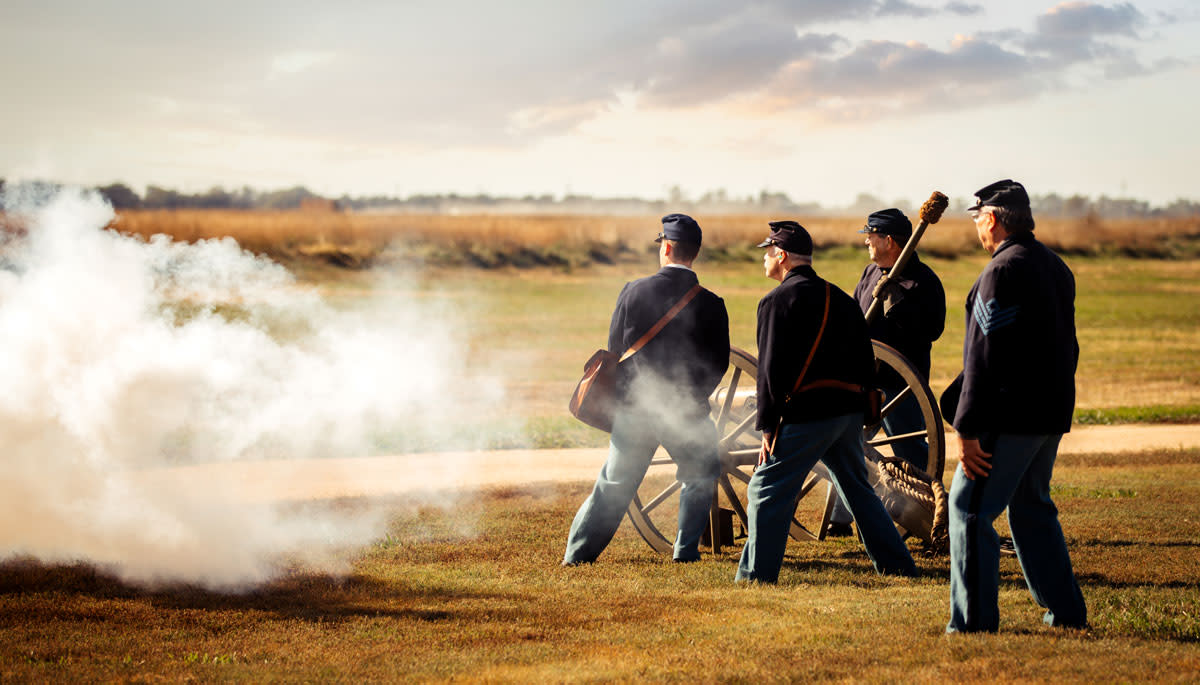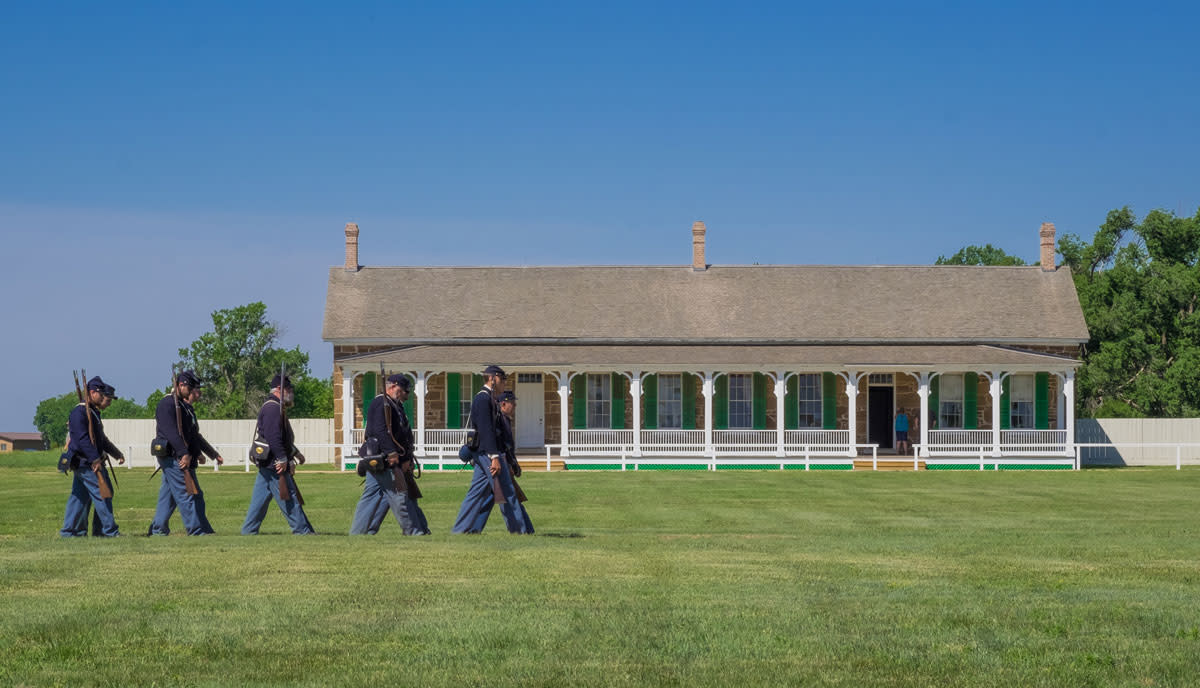
Even before Kansas was admitted to the union, the United States military had recognized the importance of our central location. Soldiers protected the trails, fought in wars spreading west, north and south, and battled the sometimes-harsh conditions of our four seasons.
What remains today are remnants of the past as well as active military posts that continue to aid in the defense of our freedom. Our Kansas-based military forts are more than just relics; they continue to give us a sense of pride in our state heritage.
FORT LARNED | HISTORIC SITE
As the prospect of civil war swept across the land in 1859, crews near modern-day Larned were busily constructing a fort in an effort to protect mail and trading caravans that were crossing the nation from east to west.
The installation’s first structures were made from sod, but more permanent sandstone buildings were erected in the mid-1860s following a raid on the fort. The history of Fort Larned was fleeting, barely 25 years in duration.
By 1884, the War Department in Washington, D.C. had deactivated the fort and sold the site to the Pawnee County Stockbreeders, who 18 years later sold the property to the Frizell family. They converted the site into a ranch.
In the nearly six decades to follow, the Frizell family kept the buildings on the property intact with minimal modifications.
In 1955, after a bill was presented in Congress to investigate the fort’s viability as a national monument under the National Park Service, it received favorable ratings. However, funds would be needed to purchase the large site, which instead resulted in the creation of the Fort Larned Historical Society in 1957.
All structures are original, excluding the blockhouse, which was razed in the 1880s, but along the way someone saw fit to preserve the building’s foundation, upon which an exact duplicate was rebuilt. So perhaps Fort Larned could be dubbed the nation’s most authentic historic fort.
Those who were stationed here more than a century and a half ago would easily recognize Fort Larned if they could see it today.

FORT RILEY | ACTIVE
What started as a post to protect settlers on the Santa Fe Trail has now become one of the busiest communities in Kansas.
Fort Riley, an active military base, has grown so large that the Public Affairs Office produces several guides and maps for visitors every year. The installation not only supports soldiers and their families, but welcomes visitors with an array of colorful affairs and outdoor recreational activities.
Fort Riley boasts an always full community calendar, with extravagant events celebrating military heroes past and present. One of the strongest links to the post’s past is the Commanding General’s Mounted Color Guard. Both troopers and horses don historic uniforms and equipment used during the Civil War to treat audiences to a colorful spectacle. You can find these impressive displays at one of the many community events, parades and ceremonies in the fort.
While you’re at one of these celebrations, you may also find yourself enjoying a performance from the 1st Infantry Division Band. These musicians have gained attention not only throughout the state, but across the nation.

FORT SCOTT | HISTORIC SITE
Deep in the heart of southeast Kansas, nestled between rolling hills and prairie, lays an exciting opportunity to connect with history and nature at the same time.
Founded in 1842, Fort Scott grew rapidly thanks to soldiers planting their roots in the area during the Civil War. The base was intended to connect the gap between northern and southern military communities. Likewise, the soldiers also helped keep the peace between Native Americans and relocating tribes, furthering the region’s expansion.
Ever since it was established as a historic site in 1978, Fort Scott has offered a plethora of activities. Visitors have been known to indulge in virtual reenactments, partake in thought-provoking discussions, enjoy colorful art exhibits and even wander off on a free, self-guided tour.
Even if history is of no interest to you, the sheer natural beauty of Fort Scott should be enough to attract any nature buff. The region is home to the Osage Cuestas, a cluster of hills with a steep face on one side and a gentle slope on the other. As a Kansan (or a visitor), you may find the urge to meander through the five acres of restored Tallgrass Prairie to take it all in.

FORT LEAVENWORTH | ACTIVE
Nearly 200 years ago, the U.S. Army established Fort Leavenworth on the banks of the Missouri River, in part to protect travelers on the Santa Fe Trail.
“It’s one of the oldest, if not the oldest continually operated post west of Washington D.C.,” says George Moore, curator of the Frontier Army Museum, located at the fort.
From its earliest days up till today, the fort and its soldiers have been at the center of key events that shaped the country. Historic buildings, Buffalo Soldier Memorial Park and Fort Leavenworth National Cemetery on the installation grounds tell part of the story and welcome visitors.
Did You Know: Since its founding in 1827, Fort Leavenworth has never been closed, though for a time during the Civil War it housed Kansas militia volunteers instead of soldiers.
The collections of the museum tell more, beginning with the Army’s role in the Lewis and Clark expedition of 1804 (almost 25 years before the Fort’s founding in 1827) through the pursuit of Pancho Villa in 1916. The museum also preserves the history of the fort, from its earliest days to its present role as home to the U.S. Army Command and General Staff College.
“Everything’s compelling,” says Moore, but he lists two must-see items for all museum visitors: Gen. Henry Leavenworth’s 1832 officer coat, and a portrait of Gen. Leavenworth painted by George Catlin.
The museum is open 9 a.m.-4 p.m. Tuesday through Friday and 10 a.m.-4 p.m. Saturday. Visitors must show a valid picture ID to enter the post.

FORT HAYS | HISTORIC SITE
Fort Hays had a specific purpose from its inception: to provide goods and materials to other forts in the area. A tragic flood in 1867 greatly increased the fort’s importance as a supplier. The flood, which wiped out nine soldiers and civilians, forced the fort to move 15 miles east—to its existing location—and near a railroad right-of-way, springing forth a large supply depot that eventually made the fort a major supplier for several other U.S. Army posts, primarily in western Kansas. Fort Hays became the home base for troops defending the Union Pacific Railway.
Famous figures such as Wild Bill Hickok, Buffalo Bill Cody and Lt. Col. George Custer often visited Fort Hays, where almost 600 troops were stationed in its early years. Several Indian war regiments also lived on the fort, including the Seventh U.S. Cavalry, the Fifth U.S. Infantry, and the 10th U.S. Cavalry. The 10th included several black troopers, known as Buffalo Soldiers.
Troops left the fort for good in November 1889.
Now the fort operates as the Fort Hays State Historic Site, complete with a Visitor Center, four original buildings, and photographs and foundations of other buildings. The Visitor Center includes rare and fun artifacts, such as Custer’s dumbbell, which he used to stay fit while visiting.

FORT WALLACE | HISTORIC SITE
Situated along a popular trail that ran from Kansas to Colorado, Fort Wallace earned a reputation as the “Fightin’est Fort in the West” for its role in the early Native American wars. The fort’s history is marked by confrontations with surrounding tribes angered by pioneers’ negative effect on buffalo populations. Exemplifying the fort’s contentious existence is an account of Lt. Col. George Custer’s discovery of the disfigured bodies of Lt. Lyman Kidder and 10 men from Fort Wallace’s Seventh Calvary, who had set out to relay messages to Custer as he pursued Native Americans through Kansas, Nebraska and Colorado.
Later, Custer was court-martialed and received a one-year suspension after he deserted his post at Fort Wallace in order to find his wife, Libby, from whom he’d been separated, according to Jayne Humphrey Pearce, president of the Fort Wallace Museum.
“My heart goes toward the stories,” Pearce says, adding that Custer’s story is just one of many the museum brings to life through artifact exhibits and illustrations by renowned Kansas painter Jerry Thomas. “They are compelling, and we help create that experience for you.”
GONE BUT NOT FORGOTTEN
Fort Zarah was established in 1864 in Barton County near the territory that would eventually be named Great Bend. It was active for only five years.
Fort Harker was originally built as Fort Ellsworth in 1864, but was later relocated to the area now known as Kanopolis. It opened in 1866, named after Civil War general Charles Garrison Harker. Gen. Philip Henry Sheridan took over as commander two years later as he planned his campaign against the Plains Indians. After the end of the wars with the Plains Indians, the fort was abandoned in 1872.
Fort Dodge was named for Brig. Gen. Grenville M. Dodge and established in 1865. Situated along the Santa Fe Trail, the fort was developed to protect passing wagons. Gen. Philip Henry Sheridan and Gen. Alfred Sully served as commanders before the fort was abandoned in 1882.





